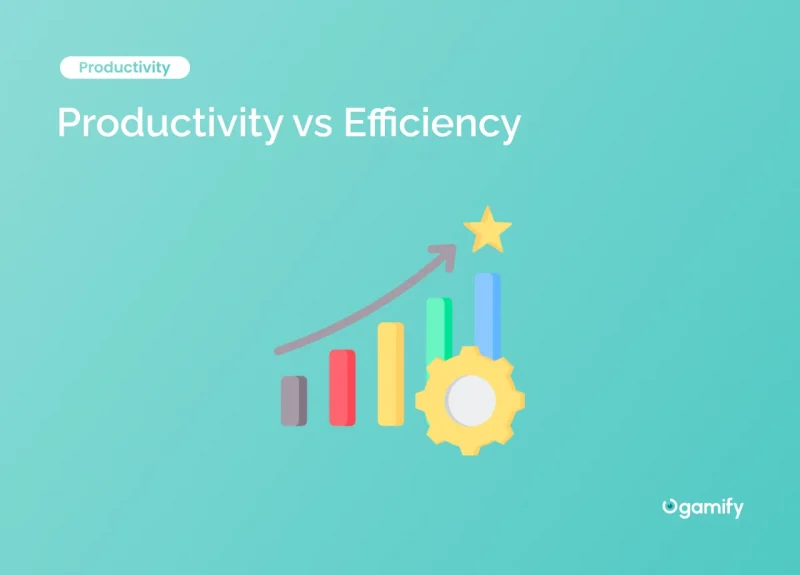Understanding the concepts of productivity and efficiency is crucial for success. While these terms are often used interchangeably, they have distinct meanings, and striking a balance between them is essential for optimal performance. In essence, productivity refers to the quantity of output, while efficiency focuses on the quality of work done.
Actual productivity is the ability to produce many items or complete numerous tasks within a specified time frame. It is a key metric used to assess the performance of individuals or machines in various industries. On the other hand, efficiency measures how effectively resources, like time and effort, are utilized to accomplish tasks. Efficiency in the workplace is essential for minimizing waste and making the best use of available resources.
When considering the difference between productivity and efficiency, it is essential to recognize that both concepts are interdependent and crucial for overall success. Striving for high productivity without considering efficiency can lead to poor quality work while focusing solely on efficiency can limit the overall output. To excel, businesses and individuals must strive to improve efficiency and productivity in their daily operations.
Defining the Concepts

To understand the difference between productivity and efficiency, it is important to define these concepts and explain their significance in the workplace. In this section, we will be examining the definitions of productivity and efficiency and the concept of productive efficiency.
Defining Productivity
At its core, productivity dances with alacrity in quantifiable output, adroitly capturing the sheer volume of work accomplished within defined temporal confines. Acting as a steadfast compass, it meticulously charts the course towards achieving objectives, whether in churning out goods or assessing the performance of indomitable human resources and machines.
The heartbeat of the business, productivity, is a metric that resonates far and wide, heralding the heralds of success and spurring enterprises to traverse the uncharted terrain of fierce market competition.
Workplace Productivity Example
Picture this: A well-oiled assembly line where skilled workers harmoniously orchestrate the production of intricate machinery parts. Here, productivity vs efficiency finds fertile ground, showcasing their symbiotic relationship in full bloom.
At the helm of this vibrant operation is a masterful production manager who understands the significance of productive efficiency. With a keen eye for detail and a penchant for optimization, this visionary leader has streamlined the production process, ensuring the smooth flow of raw materials and minimizing idle time. The workers, inspired by this management philosophy, are driven to give their best, resulting in an upsurge of efficiency productivity that reverberates throughout the workplace.
The productive efficiency in action is exemplified through the minimized downtime between tasks, the reasonable allocation of resources, and the relentless pursuit of quality output. With an unwavering focus on the symphony of efficiency and productivity, the manufacturing plant experiences a remarkable increase in production rates and a reduction in overall operational costs. This success not only heightens profitability but also bolsters the competitive edge in the market.
Defining Efficiency

In stark contrast to productivity’s spotlight on sheer output, calculating efficiency dons a cloak of finesse, masterfully orchestrating the judicious utilization of resources to attain desired outcomes. It is a symphony of precision, harmonizing the symmetrical dance of minimizing input while maximizing output.
Efficiency becomes the lodestar for minimizing waste, ensuring the parsimonious allocation of time, energy, and resources in the intricate fabric of production processes.
Workplace Efficiency Example
In this realm of technological ingenuity, the concept of productive efficiency is not just a definition on paper; it breathes life through every line of code and every seamless integration. The company’s visionary leadership has fostered an environment that values time as a treasured asset, sparing no effort in optimizing the utilization of fewer resources.
A vital aspect of this workplace efficiency example is the agile development approach, where teams collaborate in iterative cycles, swiftly adapting to evolving project requirements. Each team member is encouraged to think about their tasks and how their contributions seamlessly blend into the overarching project. This holistic approach ensures that every ounce of effort poured into the development process adds value, exemplifying the spirit of efficiency and productivity in the workplace.
The remarkable outcome of this focus on efficiency and productivity is evident in the timely delivery of cutting-edge software solutions. Projects that once seemed arduous are now executed with finesse, thanks to the efficiency-driven workflows. By maximizing output and minimizing redundant efforts, the software development company reaps the benefits of shorter development cycles, satisfied clients, and amplified goodwill within the industry.
Productive Efficiency Definition
Productive efficiency is a concept that combines both productivity and efficiency, focusing on the optimal use of inputs to produce a given output. In other words, a business or individual is considered to be productively efficient if it can produce the desired result using the least amount of fewer resources possible.
Productive efficiency is essential for businesses and individuals to maximize their potential and achieve their objectives without wasting time or resources. Organizations can enhance their overall performance and achieve a competitive edge in the market by implementing strategies and techniques to improve productivity and efficiency.
Contrasting Productivity and Efficiency

Exploring the Difference
Productivity and efficiency are concepts that are commonly used interchangeably in the context of work performance. However, they have distinct differences. In essence, the productivity formula refers to the quantity of work produced, while efficiency refers to the quality of work.
Productivity is measured by the output produced per unit of input utilized. For example, if an assembly line in a produces 100 products in an hour, the productivity of that assembly line would be 100 units per hour. On the other hand, efficiency is the ratio of actual output to the maximum possible output, considering the resources consumed. Using the same example, if the assembly line operates at full capacity and produces 100 products in an hour, but the most efficient assembly line with the same resources could produce 120 products in an hour, the efficiency would be 100/120 or approximately 83%.
Productivity Efficiency Contrast
As established earlier, productivity focuses on quantity, while efficiency focuses on quality. To ensure a balanced work output, it is essential to maintain a good relationship between productivity and efficiency.
For example, say an employee manages to complete 10 tasks during their workday, but the quality of their work is poor, resulting in incomplete or incorrect output. This means that the employee has high productivity but low efficiency. Conversely, if an employee completes 4 tasks during their workday but ensures that the job task is done flawlessly, the employee demonstrates high efficiency but low productivity.
Organizations must strike a perfect balance between productivity and efficiency in an ideal situation. This balance can be achieved through continuous improvement of work processes, skill development, and allocation of appropriate resources and tools. Organizations can maximize their work performance and achieve better results by understanding the difference between productivity and efficiency.
Importance of Productivity and Efficiency

Why Productivity Matters
Measuring productivity is crucial in the workplace because it directly impacts the output and success of a business or individual. Productivity is the effectiveness of productive effort, meaning the production output produced in contrast to the level of effort put in. Individuals and businesses can accomplish more tasks in a given period by being more productive, ultimately contributing to growth and profitability.
Focusing on productivity can lead to better time management, allowing employees to allocate their energy and resources effectively. Additionally, high productivity levels can foster a positive work environment and increase job satisfaction, as employees can see the tangible results of their efforts.
Why Efficiency Matters
On the other hand, efficiency is also essential in the workplace because it is concerned with the quality of the output produced. According to the definition productive efficiency, efficiency measures how well an individual or company utilizes their resource to reduce functional production output.
They are maintaining efficient criticality key because it helps businesses use their resources, such as time and materials, to achieve maximum results. An efficient workplace produces higher-quality products or services while minimizing waste and cost, ultimately leading to increased profitability.
One reason efficiency is important is that it goes hand in hand with productivity: focusing on efficiency can uncover opportunities for improvement, boosting productivity levels. By striving for both productivity and efficiency, businesses can create a balanced approach that optimizes resources, improves output quality, and encourages sustainable growth.
Conclusion

Productivity and efficiency are two essential concepts in business and personal performance. While they may seem similar, they refer to different aspects of work performance. Productivity measures the total output generated in a given time, whereas efficiency refers to the quality of work and healthy good resources used to accomplish critical tasks.
A key factor in understanding the difference between these concepts recognizes that productivity focuses on the quantity of work, whereas efficiency concerns the quality of work. This means that a highly productive individual or organization may not be efficient if they waste resources, such as time and energy, to achieve their output. On the other hand, highly efficient people might not have production output, but they make the best use of their available resources to achieve their goals.
In the context of production efficiency, it refers to the optimal use of resources to produce goods and services while minimizing wastage. This is a crucial aspect of efficiency that can significantly impact the overall success of a business. Companies that achieve high production efficiency can lower costs and deliver their products at competitive prices, giving them an edge in the market.
FAQ
What is productivity?
Productivity is the ability to produce many items or complete numerous tasks within a specified time frame. It is a key metric used to assess the performance of individuals or machines in various industries.
What is efficiency?
Efficiency in the workplace is essential for minimizing waste and making the best use of available resources. Efficiency measures how effectively resources, like time and effort, are utilized to accomplish tasks.
What is the difference between productivity and efficiency?
Productivity refers to the quantity of output, while efficiency focuses on the quality of work done. Productivity is the ability to produce many items or complete numerous tasks within a specified time frame. At the same time, efficiency measures how effectively resources, like time and effort, are utilized to accomplish tasks.
Why is striking a balance between productivity and efficiency important?
Striking a balance between increasing productivity and improving efficiency is essential for optimal performance. True productivity is necessary to produce results quickly, while efficiency is important for the best use of available resources.
How can I maximize productivity and efficiency in the workplace?
To maximize productivity and efficiency in the workplace, it is important to use effective time management techniques, plan each day’s tasks in advance, take regular breaks, and recognize employees for their hard work and accomplishments. Additionally, implementing effective workflow and task management tools can help streamline processes and eliminate wasted time and effort.


